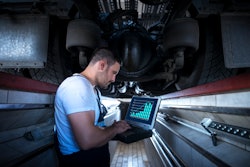
With the words “freight efficiency” in our name and a mission to double it, you would think that the North American Council for Freight Efficiency (NACFE) would have a pretty good idea of how to measure it.
Like the rest of the industry, we have found it to be much more complicated than perhaps Mike Roeth, NACFE’s executive director, or anyone else who was at the founding of NACFE in 2010 may have imagined.
Ten years ago, when people spoke about freight efficiency, it still mostly meant MPG for equipment burning diesel fuel while hauling goods across long distances. There were — and still are — variations on MPG.
CNG/LNG trucks measure their efficiency in diesel equivalent MPG, a measure that equalizes the energy content of natural gas to diesel. Railroads and ships prefer freight ton efficiency (FTE), which is MPG multiplied by the weight of the goods moved in tons, to compare systems that have much different capacities. But the fact is, these are variations on MPG, a measure of how far you can go using the energy you obtain from burning a gallon of diesel.
So, what has happened in the last 10 years?
Two words: free shipping.
This was around before 2010, but has had a huge impact on how we think about goods movement and energy usage in the past decade.
Here is an example that is probably playing out thousands of times across this country in the time it takes to read this: I happen to be in the process of shopping for a vacuum cleaner. My wife and I already knew what we wanted so it was a matter of figuring out where to get it. This brand is really good at enforcing its retail pricing so the price is the same no matter where I get it. In spite of that, the first place I turned to was online because I expected to get free shipping. I like the idea of having it brought to my house so much that I don’t even consider going to the store for it, and went to the manufacturer’s website to place my order. But the manufacturer’s website couldn’t process my credit card. After trying again and even calling them, I gave up and ended up buying it from a store that’s a mile from my house.
Which brings me to the step of getting that vacuum cleaner home. I didn’t actually go to the store, but rather ordered it online for curbside pickup. My preference would have been to have the store ship it to me, but since they charge for this literal last mile, I chose pick-up.
Now, almost a week later and despite three reminders that the order is ready, I have yet to actually go get it. Part of it is that I don’t want to take the time, but part of it is also that I don’t like driving our 5,000+ lb. gas burning vehicle out of my way to pick up a single package.
I usually don’t think about freight efficiency in my personal life, but for someone who works to increase it this one transaction illustrates how important and complex the measurement of freight efficiency has become and how metrics such as MPG, or its variants like FTE, don’t always work.
In order to think about this, I will assume at one point two vacuum cleaners sat in a warehouse somewhere in the vicinity of where I live. (Since I live in a metro area with about a million people, probably not a terrible assumption.) One is loaded on a delivery truck and ships directly to my house with stops along the way for the other goods on the same truck. The other ships to the store, also with many other goods, where I will go to get it.
What is the freight efficiency of each route? How do I even calculate it? Assuming I know the distance the delivery truck traveled and the amount of fuel it used, that would get me to an MPG for the truck. But how does that relate to the package? Would it make a difference whether my house was the first stop on the route versus the last or whether the other deliveries all happened to be very light but space consuming popcorn, or kitty litter which weighs a lot?
All of these questions apply to the store delivery as well and maybe a few more. What if the truck was only partly full but made stops at multiple stores and picked up some items as well? And it’s not quite apples-to-apples since I still have to go get the vacuum and bring it to the house. Throw in some electric or hybrid trucks – maybe a Tesla instead of our current car for my run to the store – and both the miles and gallons part of the equation are out the window.
I’m trying to think of a different way to consider this and have searched around for how others have talked about it. By no means do I have this figured out, but I realize that thinking about the route the truck took or how much my package weighed versus all of the others on the truck is overly complicated.
A different way to look at this may be in terms of the benefit (or value) the freight movement creates instead of the actual distance covered or the size and weight of the package. Economists have a word for this value — utility. In this case, my utility from this delivery is getting a vacuum cleaner from the warehouse to my house.
It doesn’t matter if the truck made one stop or 20 before it got to me, my utility is still the delivery of one package over a distance from the warehouse to my door. Using this paradigm, I also ignore weight and size (within what’s reasonable for a package delivery) since my utility wouldn’t be any higher if I had bought a heavier vacuum cleaner or one that came in a bigger box.
We use this way of thinking when we talk about transporting people instead of freight. Assuming the trip takes the same amount of time, we don’t care whether the bus took the highway or a shorter way through town. Nor is it more valuable because a person weighs 200 lbs. instead of 100 lbs. The value of the transportation — its utility — stays the same for each person.
So, what do I do with this? As I said, freight efficiency doesn’t really factor into my personal life. But from a freight system standpoint, it helps me compare the efficiency of the two ways that the vacuum cleaner could have arrived at my house.
For the direct delivery to my door, I only have to know how many delivery stops the package truck made and the direct — as the crow flies — distance from the pickup point to each drop point. Multiply the number of stops by all of the individual distances, add it up and I get to the total utility created by that truck that day. We could call that delivery-miles. I can then divide delivery-miles by whatever resource I want to consider (such as energy) and I get a freight efficiency of delivery-miles per unit of energy.
It’s a little more complicated but still do-able for the warehouse-to-store-to-home route. I would need an estimate of how many equivalent packages were delivered from the warehouse to each store (I could use an average package weight if I knew the total weight on the truck) to calculate the utility created for each store and thereby allocate the energy used in that phase for each package to get to the store. I then add in the energy needed to get to the store from my house to arrive at the total energy saved.
Finally, to get to an equivalent delivery-miles per unit of energy, I use the direct distance from the warehouse to my house and ignore the store (remember, I don’t care how many stops the package made) and divide by the total energy, and there I have a way to compare the energy consumed by each method to create the same utility.
There is also the challenge of factoring for reverse logistics, the reality that e-commerce purchases have a higher rate of being returned than in store purchases, and trying to figure out what actually happens to the returned merchandise. But we’ll leave that for another blog.
It’s not perfect and, from a system perspective, I would have to use some average statistics such as the average distance to a store or the average weight of a package but these numbers are out there. However, it could be one way to measure and compare freight efficiency in our new and much more complicated normal.
Yunsu Park is the Director of Engineering for NACFE and an independent consultant in the trucking industry. He has authored several Confidence Reports for NACFE in addition to the summary report for 2017 Run on Less. Park’s area of interest is in data collection and analysis, and technology implementation, particularly as it relates to human behavior. Prior to NACFE, Park was CTO for a technology start-up working with fleets on driver behavior and incentives and held various roles in finance and engineering at Navistar.









